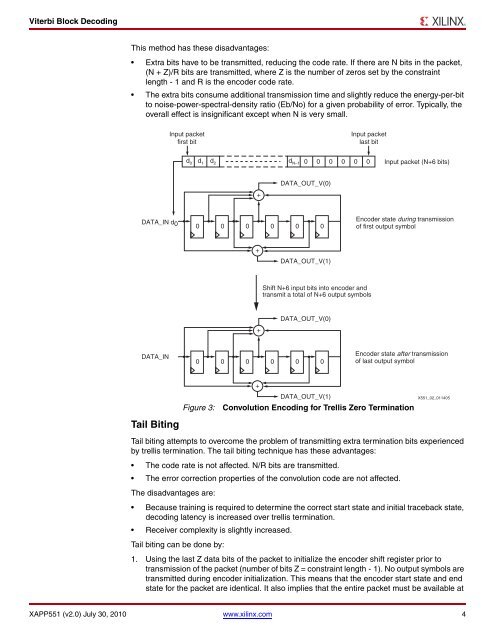Xilinx XAPP551 Viterbi Decoder Block Decoding - Trellis ...
Xilinx XAPP551 Viterbi Decoder Block Decoding - Trellis ...
Xilinx XAPP551 Viterbi Decoder Block Decoding - Trellis ...
Create successful ePaper yourself
Turn your PDF publications into a flip-book with our unique Google optimized e-Paper software.
<strong>Viterbi</strong> <strong>Block</strong> <strong>Decoding</strong><br />
This method has these disadvantages:<br />
Extra bits have to be transmitted, reducing the code rate. If there are N bits in the packet,<br />
(N + Z)/R bits are transmitted, where Z is the number of zeros set by the constraint<br />
length - 1 and R is the encoder code rate.<br />
The extra bits consume additional transmission time and slightly reduce the energy-per-bit<br />
to noise-power-spectral-density ratio (Eb/No) for a given probability of error. Typically, the<br />
overall effect is insignificant except when N is very small.<br />
X-Ref Target - Figure 3<br />
DATA_IN d 0<br />
DATA_IN<br />
Tail Biting<br />
Input packet<br />
first bit<br />
d 0<br />
d 1<br />
d 2<br />
Encoder state during transmission<br />
of first output symbol<br />
+<br />
DATA_OUT_V(1)<br />
Figure 3: Convolution Encoding for <strong>Trellis</strong> Zero Termination<br />
Tail biting attempts to overcome the problem of transmitting extra termination bits experienced<br />
by trellis termination. The tail biting technique has these advantages:<br />
The code rate is not affected. N/R bits are transmitted.<br />
The error correction properties of the convolution code are not affected.<br />
The disadvantages are:<br />
Because training is required to determine the correct start state and initial traceback state,<br />
decoding latency is increased over trellis termination.<br />
Receiver complexity is slightly increased.<br />
Tail biting can be done by:<br />
1. Using the last Z data bits of the packet to initialize the encoder shift register prior to<br />
transmission of the packet (number of bits Z = constraint length - 1). No output symbols are<br />
transmitted during encoder initialization. This means that the encoder start state and end<br />
state for the packet are identical. It also implies that the entire packet must be available at<br />
<strong>XAPP551</strong> (v2.0) July 30, 2010 www.xilinx.com 4<br />
+<br />
+<br />
+<br />
d N–1<br />
0<br />
0<br />
DATA_OUT_V(0)<br />
0 0 0 0 0 0<br />
DATA_OUT_V(1)<br />
DATA_OUT_V(0)<br />
0 0 0 0 0 0<br />
0<br />
0<br />
Input packet<br />
last bit<br />
Shift N+6 input bits into encoder and<br />
transmit a total of N+6 output symbols<br />
0<br />
0<br />
Input packet (N+6 bits)<br />
Encoder state after transmission<br />
of last output symbol<br />
X551_02_011405

















